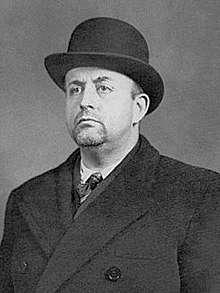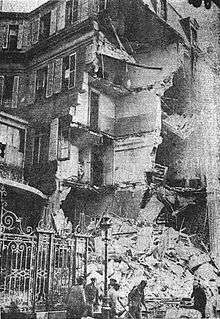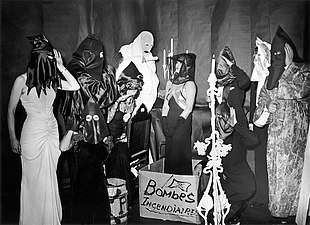La Cagoule
La Cagoule (The Cowl, press nickname coined by the Action Française nationalist Maurice Pujo), officially called Comité secret d'action révolutionnaire (Secret Committee of Revolutionary Action), was a French fascist-leaning and anti-communist terrorist[1] group that used violence to promote its activities from 1935 to 1941.
It developed to overthrow the French Third Republic, led by the Popular Front government, an alliance of left-wing groups. La Cagoule was founded by Eugène Deloncle. Among others, the founder of the cosmetics company L'Oréal, Eugène Schueller, bankrolled the clandestine movement.
The group performed assassinations, bombings, sabotage of armaments, and other violent activities, some intended to cast suspicion on communists and add to political instability. Planning a November 1937 overthrow of the government, La Cagoule was infiltrated by the police, and the national government arrested and imprisoned about 70 men. At the outbreak of World War II, the government released the men to fight in the French Army. Some supported other right-wing organizations and participated in the Vichy government; others joined the Free French of Charles de Gaulle. It was not until 1948 that the government tried surviving members for the charges of 1937.
In the Third Republic

The group was founded in 1936–1937 by Eugène Deloncle. Because most of its members were bourgeois ,the group enjoyed privileged relations within industrial circles (National Federation of ratepayer, Company Lesieur, L'Oréal, etc).[2]
An important member was Joseph Darnand, who later founded the Service d'ordre légionnaire (SOL), the forerunner of the Milice, the Collaborationist paramilitary of the Vichy regime. His nephew Henri Charbonneau was also a member. Jean Filiol was a member. He was appointed as the head of the Milice in Limoges, and fled to Spain at the end of World War II, where he worked in the Spanish subsidiary of L'Oréal. Gabriel Jeantet, who was a lover of a sister of François Mitterrand who later recommended him for the Francisque.[3] Dr. Henri Martin, a medical doctor who is suspected of having forged the Pacte Synarchique, and worked for the Organisation armée secrète (OAS) after World War II.[4] Mohammed El Maadi, head of La Cagoule for French Algeria, creator of the antisemitic newspaper Er Rachid, and organizer of the North-African Brigade, known as SS-Mohammed, in 1944.
The group drew most of its members from Orléanists disappointed by the lack of action by Action Française, which was founded by Charles Maurras. They were opposed to the Popular Front government, created from an alliance of left-wing groups. Historians believe many low-level members were recruited in the belief that it was an auto-defense organization, intended to fight against a Communist takeover.[3]
In Nice, new members were initiated in a formal ritual. In the presence of the Grand Master, dressed in red and accompanied by his assesseurs dressed in black, with their faces covered, new members stood before a table draped with a French flag. A sword and torches were placed on it. Each man raised his right arm and swore the oath, Ad majorem Galliæ gloriam ("For the greater glory of France").[5] This oath echoed the Jesuit motto, Ad Majorem Dei Gloriam (For the greater glory of God). Disloyalty was punished by death. For instance, the arms suppliers Léon Jean-Baptiste and Maurice Juif were murdered by Cagoulards in October 1936 and February 1937, respectively, for attempting to enrich themselves by lying about the price they had paid for the arms.
The paramilitary organization was active in the provinces. In Paris it organized militias and demonstrations, and it amassed arms. They attempted to assassinate Léon Blum, the prime minister. They also trained men in terrorism, built underground prisons, and "ran guns in Belgium, Switzerland and Italy."[3]

La Cagoule directed its members in various actions aimed at creating suspicions of Communists to destabilize and destroy the French Republic. Some argue that on 26 January 1937 Jean Filiol stabbed to death Dimitri Navachine, a Russian national and for several years the respected director of the Paris branch of the Soviet State Bank, in the Bois de Boulogne.[3] Others believed that he had been killed by Joseph Stalin's Secret Service, the NKVD, as the Great Purge was underway in the Soviet Union.[6] To ease their obtaining arms from fascist Italy, on 9 June 1937, the group assassinated two Italian antifascists, the Rosselli brothers, who were refugees in France.[7][8] They sabotaged airplanes clandestinely supplied by the French government to the Spanish Republic. On 11 September 1937, the Cagoule blew up two buildings owned by the Comité des Forges (Ironmasters Association), to create the impression of a communist conspiracy. Although it was widely believed at the time that communists had set the bombs, the government took no official action against the French Communist Party, to the disappointment of Cagoulards. The Cagoule tried to infiltrate the International Brigades for the same purpose.

Organized along military lines, the Cagoule infiltrated parts of the French military via Georges Loustaunau-Lacau's Corvignolles organization (as a means to acquire weapons).[9] They prepared to overthrow the Popular Front government in November 1937 to install a fascist government. The Cagoulards initially intended to make Philippe Pétain chief of state. Pétain refused their overtures, and they chose Marshall Louis Franchet d'Esperey as their future chief of state.
The Cagoule was infiltrated by the French police. On 15 November 1937, Marx Dormoy, Minister of the Interior (and the top officer of law enforcement), denounced their plot and ordered wide arrests of members. The French police seized 2 tons of high explosives, several anti-tank or anti-aircraft guns, 500 machine guns, 65 submachine guns, 134 rifles and 17 sawn-off shotguns.[10] Some of the arms were of German or Italian origin. About 70 men were arrested. Deloncle had boasted that he had 12,000 men under his order in Paris, and 120,000 in the provinces, but it is likely there were no more than 200 men who knew much about the organization and its structure, and another several hundred who were more loosely affiliated with the group.[3]

Reactions to the plot and the revelations by the French government about la Cagoule varied among the international media. In the United States, the editors of the New York Times were initially suspicious of the accounts. The journalists of Time magazine likened La Cagoule to the American Ku Klux Klan, a right-wing group that had a widespread revival from 1915, reaching its peak of influence in 1925, with members elected to political office in midwestern cities and states as well as the South.
At the outbreak of World War II, the French government released imprisoned cagoulards to fight in the French Army. Some entered the Milice, as did Jacques de Bernonville.
During the Occupation of France in 1940, the Vichy government arrested Marx Dormoy, as he had refused to vote for full powers for Marshal Philippe Pétain. They eventually interned him under house arrest at Montélimar. He was assassinated on 26 July 1941 by a clockwork bomb set off at the house. It was believed to have been done by La Cagoule terrorists, in reprisal for Dormoy's arrests in 1937 and attempt to suppress the organization.[11]
Organization of the Cagoule
- Premier Bureau: Eugène Deloncle and Jacques Corrèze
- Deuxième Bureau (intelligence): Dr. Henri Martin, Alfred Corre (Dagore)
- Troisième Bureau (operations): Georges Cachier
- Quatrième Bureau (recruits and equipment): Jean Moreau de La Meuse
- Sources of funding: Eugène Schueller, Louis Renault, Lemaigre Dubreuil (owner of table oil Lesieur and department stores Le Printemps), Gabriel Jeantet (Lafarge cements), Pierre Pucheu (Comptoir Sidérurgique)
La Cagoule was organized into cells. Light cells comprised 8 men armed with submachine guns (typically one per light cell), rifles, semi-automatic pistols and hand grenades. Heavy cells comprised 12 men, armed with a heavy machine gun and the individual weapons. A group of three cells formed one unit, three units a battalion, three battalions a regiment, two regiments a brigade, and two brigades a division. Battalions could be divided into automobile squads of about 50 men. Written communications were avoided as much as possible. The "street fighting" handbook was titled Secret Rules of the Communist Party to avoid revealing La Cagoule in case the booklet was found by the police.[12]
World War II and after
During World War II, members of the Cagoule were divided. Some of them joined various Fascist movements; Schueller and Deloncle founded the Mouvement Social Révolutionnaire, which conducted various pro-Nazi Germany activities in occupied France. It bombed seven synagogues in Paris in October 1941. Others became prominent members of Philippe Pétain's Vichy Regime. Darnand was the leader of the Milice, the Vichy paramilitary group who fought the French Resistance, and enforced anti-semitic policies. He took an oath of loyalty to Adolf Hitler after accepting a Waffen SS rank.
Other cagoulards sided against the Germans, either as members of the Resistance (such as Marie-Madeleine Fourcade, Pierre Guillain de Bénouville or Georges Loustaunau-Lacau in the Maquis), or as members of Charles de Gaulle's Free French Forces, such as General Henri Giraud or Colonel Passy. After the war, the writer Henri de Kérillis accused de Gaulle of having been a member of La Cagoule; he said that De Gaulle was ready to install a fascist government if the Allies let him become France's chief of state.[13]
The cagoulards arrested for the 1937 conspiracy were not brought to trial for those charges until 1948, after the liberation of France. By then many had served in the Vichy government or the Resistance, and few were brought to trial.[3]
References
- ↑ Cullen, S. (2018) World War II Vichy French Security Troops, Osprey Pub.
- ↑ Winock, Michel (1993) Histoire de l'extreme droite en France. ISBN 2020232006
- 1 2 3 4 5 6 Finley-Croswhite, Annette and Brunelle, Gayle K. "Murder in the Metro", Quest, Old Dominion University, accessed 24 July 2012
- ↑ Péan, Pierre (1993) Le Mystérieux docteur Martin, 1895–1969. Fayard
- ↑ Kauffer, Rémi (1 July 2007). "La Cagoule tombe le masque". Historia. 108.
- ↑ "Foreign News: Stalin, Navachine & Blum", Time Magazine, 8 February 1937, accessed 24 July 2012
- ↑ Pugliese, Stanislao G. (1997). "Death in Exile: The Assassination of Carlo Rosselli". Journal of Contemporary History. 32 (3): 305–319. JSTOR 260963.
- ↑ Agronsky, Martin (1939). "Racism in Italy". Foreign Affairs. 17 (2): 391–401. doi:10.2307/20028925. JSTOR 20028925.
- ↑ "Monstrous Conspiracy", Time Magazine, 6 December 1937
- ↑ "Terrible Gravity", Time Magazine, 29 November 1937
- ↑ "Death by bomb", Time Magazine, 4 August 1941
- ↑ Spivak, John L. (1939). "Ch. III. Secret Armies, the new tactics of Nazi warfare". France's Secret Fascist Army. New York: Modern Age Books. p. 31.
- ↑ de Kérillis, Henri (1946) I Accuse De Gaulle Harcourt, Brace & Co.
External links
| Wikimedia Commons has media related to La Cagoule (CSAR). |